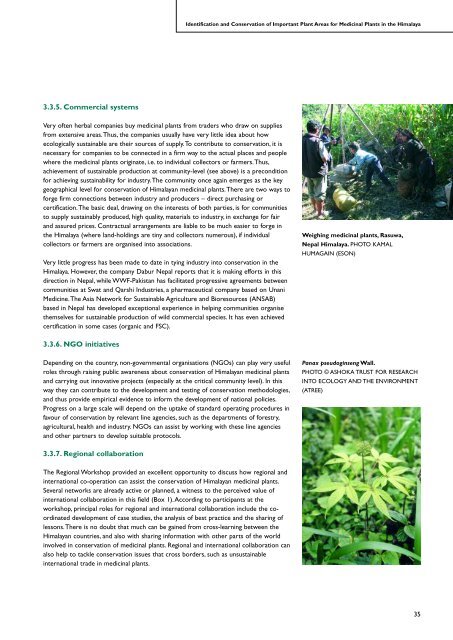Identification and Conservation of Important Plant Areas - Plantlife
Identification and Conservation of Important Plant Areas - Plantlife
Identification and Conservation of Important Plant Areas - Plantlife
- No tags were found...
You also want an ePaper? Increase the reach of your titles
YUMPU automatically turns print PDFs into web optimized ePapers that Google loves.
<strong>Identification</strong> <strong>and</strong> <strong>Conservation</strong> <strong>of</strong> <strong>Important</strong> <strong>Plant</strong> <strong>Areas</strong> for Medicinal <strong>Plant</strong>s in the Himalaya3.3.5. Commercial systemsVery <strong>of</strong>ten herbal companies buy medicinal plants from traders who draw on suppliesfrom extensive areas.Thus, the companies usually have very little idea about howecologically sustainable are their sources <strong>of</strong> supply.To contribute to conservation, it isnecessary for companies to be connected in a firm way to the actual places <strong>and</strong> peoplewhere the medicinal plants originate, i.e. to individual collectors or farmers.Thus,achievement <strong>of</strong> sustainable production at community-level (see above) is a preconditionfor achieving sustainability for industry.The community once again emerges as the keygeographical level for conservation <strong>of</strong> Himalayan medicinal plants.There are two ways t<strong>of</strong>orge firm connections between industry <strong>and</strong> producers – direct purchasing orcertification.The basic deal, drawing on the interests <strong>of</strong> both parties, is for communitiesto supply sustainably produced, high quality, materials to industry, in exchange for fair<strong>and</strong> assured prices. Contractual arrangements are liable to be much easier to forge inthe Himalaya (where l<strong>and</strong>-holdings are tiny <strong>and</strong> collectors numerous), if individualcollectors or farmers are organised into associations.Very little progress has been made to date in tying industry into conservation in theHimalaya. However, the company Dabur Nepal reports that it is making efforts in thisdirection in Nepal, while WWF-Pakistan has facilitated progressive agreements betweencommunities at Swat <strong>and</strong> Qarshi Industries, a pharmaceutical company based on UnaniMedicine.The Asia Network for Sustainable Agriculture <strong>and</strong> Bioresources (ANSAB)based in Nepal has developed exceptional experience in helping communities organisethemselves for sustainable production <strong>of</strong> wild commercial species. It has even achievedcertification in some cases (organic <strong>and</strong> FSC).Weighing medicinal plants, Rasuwa,Nepal Himalaya. PHOTO KAMALHUMAGAIN (ESON)3.3.6. NGO initiativesDepending on the country, non-governmental organisations (NGOs) can play very usefulroles through raising public awareness about conservation <strong>of</strong> Himalayan medicinal plants<strong>and</strong> carrying out innovative projects (especially at the critical community level). In thisway they can contribute to the development <strong>and</strong> testing <strong>of</strong> conservation methodologies,<strong>and</strong> thus provide empirical evidence to inform the development <strong>of</strong> national policies.Progress on a large scale will depend on the uptake <strong>of</strong> st<strong>and</strong>ard operating procedures infavour <strong>of</strong> conservation by relevant line agencies, such as the departments <strong>of</strong> forestry,agricultural, health <strong>and</strong> industry. NGOs can assist by working with these line agencies<strong>and</strong> other partners to develop suitable protocols.Panax pseudoginseng Wall.PHOTO © ASHOKA TRUST FOR RESEARCHINTO ECOLOGY AND THE ENVIRONMENT(ATREE)3.3.7. Regional collaborationThe Regional Workshop provided an excellent opportunity to discuss how regional <strong>and</strong>international co-operation can assist the conservation <strong>of</strong> Himalayan medicinal plants.Several networks are already active or planned, a witness to the perceived value <strong>of</strong>international collaboration in this field (Box 1).According to participants at theworkshop, principal roles for regional <strong>and</strong> international collaboration include the coordinateddevelopment <strong>of</strong> case studies, the analysis <strong>of</strong> best practice <strong>and</strong> the sharing <strong>of</strong>lessons.There is no doubt that much can be gained from cross-learning between theHimalayan countries, <strong>and</strong> also with sharing information with other parts <strong>of</strong> the worldinvolved in conservation <strong>of</strong> medicinal plants. Regional <strong>and</strong> international collaboration canalso help to tackle conservation issues that cross borders, such as unsustainableinternational trade in medicinal plants.35
















